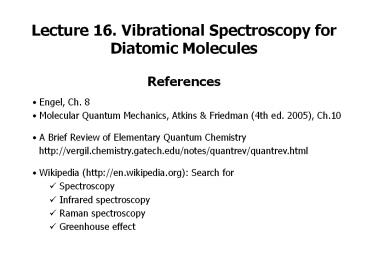Lecture 16. Vibrational Spectroscopy for Diatomic Molecules - PowerPoint PPT Presentation
1 / 17
Title:
Lecture 16. Vibrational Spectroscopy for Diatomic Molecules
Description:
Lecture 16. Vibrational Spectroscopy for Diatomic Molecules References Engel, Ch. 8 Molecular Quantum Mechanics, Atkins & Friedman (4th ed. 2005), Ch.10 – PowerPoint PPT presentation
Number of Views:977
Avg rating:3.0/5.0
Title: Lecture 16. Vibrational Spectroscopy for Diatomic Molecules
1
Lecture 16. Vibrational Spectroscopy for Diatomic
Molecules
References
- Engel, Ch. 8
- Molecular Quantum Mechanics, Atkins Friedman
(4th ed. 2005), Ch.10 - A Brief Review of Elementary Quantum Chemistry
- http//vergil.chemistry.gatech.edu/notes/quantrev
/quantrev.html - Wikipedia (http//en.wikipedia.org) Search for
- Spectroscopy
- Infrared spectroscopy
- Raman spectroscopy
- Greenhouse effect
2
(No Transcript)
3
(No Transcript)
4
(No Transcript)
5
and Transition Rate
6
(No Transcript)
7
Selection Rules
To show a vibrational spectrum, a diatomic
molecule must have a dipole moment that varies
with extension.
8
Selection Rules in
Transition probability ? 0 only if
Transition dipole moment ? 0, i.e.
? 0 only if
9
Overtone, Second harmonics
10
Greenhouse Gases and Global Warming
11
(No Transcript)
12
N2 78.1 O2 20.9 H2O 0-2 Ar (inert gases)
0.936 CO2 370 ppm CH4 1.7 ppm N2O 0.35
ppm O3 10-8 ppm other trace gases
13
CO2
v3 4.3 µm
v2 15 µm
v1 7.5 µm (IR inactive)
v3
v2
14
H2O
O
o
H
H
bend v2 6.25 µm
symmetric stretch v1 2.74 µm
asymmetric stretch v3 2.66 µm
v3
v1
v2
15
(No Transcript)
16
(No Transcript)
17
(No Transcript)

